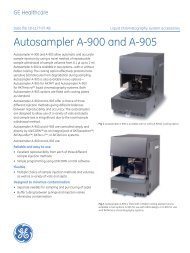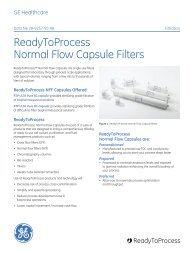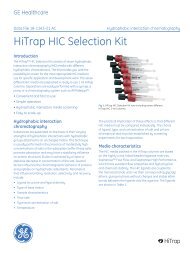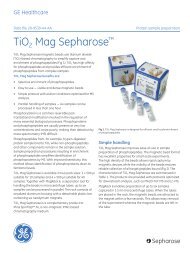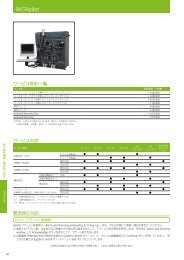Effect of flow rate, molecular weight of (His) -tagged proteins, and ...
Effect of flow rate, molecular weight of (His) -tagged proteins, and ...
Effect of flow rate, molecular weight of (His) -tagged proteins, and ...
You also want an ePaper? Increase the reach of your titles
YUMPU automatically turns print PDFs into web optimized ePapers that Google loves.
Innovations Forum: Performance <strong>of</strong> <strong>His</strong>Trap HP<br />
<strong>Effect</strong> <strong>of</strong> <strong>flow</strong> <strong>rate</strong>, <strong>molecular</strong> <strong>weight</strong> <strong>of</strong><br />
(<strong>His</strong>) 6 -<strong>tagged</strong> <strong>proteins</strong>, <strong>and</strong> expression<br />
system on the performance <strong>of</strong><br />
<strong>His</strong>Trap HP columns<br />
K. Öberg*, L. C. Andersson*, J. Lundqvist*, L. Anderson † , <strong>and</strong> H. Stålbr<strong>and</strong> †<br />
*Amersham Biosciences AB, Uppsala, Sweden<br />
† Department <strong>of</strong> Biochemistry, Lund University, Lund, Sweden<br />
(<strong>His</strong>) 6 -<strong>tagged</strong> <strong>proteins</strong> were used in studies to evaluate the purification performance<br />
<strong>of</strong> <strong>His</strong>Trap HP columns. (<strong>His</strong>) 6 -<strong>tagged</strong> maltose-binding protein (MBP-[<strong>His</strong>] 6 , M r ~43 000)<br />
expressed in E. coli was purified on <strong>His</strong>Trap HP 1 ml columns at <strong>flow</strong> <strong>rate</strong>s <strong>of</strong> 1, 2, or 4 ml/min.<br />
The yield <strong>of</strong> MBP-(<strong>His</strong>) 6 was lower at the higher <strong>flow</strong> <strong>rate</strong>s, but still satisfactory. Sample<br />
purity remained high <strong>and</strong> unaffected. A (<strong>His</strong>) 6 -<strong>tagged</strong> mannanase (M r ~100 000) <strong>and</strong><br />
a hydrolase (M r ~34 000), were expressed in E. coli <strong>and</strong> P. pastoris, respectively. The<br />
(<strong>His</strong>) 6 -mannanase was purified using a two-step protocol with a <strong>His</strong>Trap HP column<br />
followed by gel filtration on Superdex 200 10/300 GL; (<strong>His</strong>) 6 -hydrolase was purified<br />
using a one-step IMAC protocol on a <strong>His</strong>Trap HP column. High yield <strong>and</strong> purity <strong>of</strong> these<br />
(<strong>His</strong>) 6 -<strong>tagged</strong> enzymes were observed. The results <strong>of</strong> this study show that the performance<br />
<strong>of</strong> Ni Sepharose High Performance, the prepacked medium in <strong>His</strong>Trap HP columns, was<br />
not limited by <strong>flow</strong> <strong>rate</strong>, <strong>molecular</strong> <strong>weight</strong> <strong>of</strong> the three (<strong>His</strong>) 6 -<strong>tagged</strong> <strong>proteins</strong> used, or<br />
the two expression systems employed.<br />
Introduction<br />
The (<strong>His</strong>) 6 tag is the most used affinity tag due to its small size,<br />
strong metal ion binding, <strong>and</strong> ability to bind under denaturing,<br />
as well as native conditions (1, 2). Immobilized metal ion affinity<br />
chromatography (IMAC) with nickel-charged media is a welldocumented<br />
method for purifying histidine-<strong>tagged</strong> <strong>proteins</strong> ✧ (3).<br />
<strong>His</strong>Trap HP columns, prepacked with Ni Sepharose High Performance,<br />
are effective <strong>and</strong> convenient tools for this application. The medium,<br />
supplied precharged with Ni 2+ ions, strongly binds <strong>His</strong>-<strong>tagged</strong><br />
<strong>proteins</strong>, which are then easily eluted from the column.<br />
The aim <strong>of</strong> this study was to evaluate the performance <strong>of</strong> prepacked<br />
<strong>His</strong>Trap HP columns 1) at different <strong>flow</strong> <strong>rate</strong>s; 2) using (<strong>His</strong>) 6<br />
-<strong>tagged</strong><br />
<strong>proteins</strong> <strong>of</strong> diverse <strong>molecular</strong> <strong>weight</strong>; 3) in one-step or two-step<br />
purification <strong>of</strong> (<strong>His</strong>) 6<br />
-<strong>tagged</strong> <strong>proteins</strong> expressed in different hosts.<br />
High yield <strong>and</strong> purity at increased <strong>flow</strong> <strong>rate</strong><br />
C-terminally (<strong>His</strong>) 6<br />
-<strong>tagged</strong> maltose binding protein, MBP-(<strong>His</strong>) 6<br />
, was<br />
subcloned <strong>and</strong> expressed in E. coli. Prior to cell lysis, PMSF was added<br />
to a final concentration <strong>of</strong> 1 mM to prevent proteolysis. Sodium<br />
chloride <strong>and</strong> imidazole were added to the cell lysate to give final<br />
concentrations <strong>of</strong> 500 mM <strong>and</strong> 35 mM, respectively; the pH was<br />
adjusted to 7.4. The cell lysate was centrifuged <strong>and</strong> filtered prior to<br />
IMAC. Extracts with MBP-(<strong>His</strong>) 6 were loaded onto equilib<strong>rate</strong>d 1-ml<br />
<strong>His</strong>Trap HP columns at <strong>flow</strong> <strong>rate</strong>s <strong>of</strong> 1, 2, or 4 ml/min. All steps in the<br />
purification procedure i.e. equilibration, sample application, <strong>and</strong> wash<br />
were performed at these <strong>flow</strong> <strong>rate</strong>s. The imidazole concentration<br />
during equilibration, sample application, <strong>and</strong> wash was 35 mM, which<br />
reduced the amount <strong>of</strong> contaminating E. coli <strong>proteins</strong> <strong>and</strong> allowed<br />
selective binding <strong>of</strong> MBP-(<strong>His</strong>) 6<br />
. One-step elution was performed<br />
with buffer containing 500 mM imidazole <strong>and</strong> 1-ml fractions<br />
were collected. The concentration <strong>and</strong> yield <strong>of</strong> MBP-(<strong>His</strong>) 6<br />
were<br />
estimated by measurement at 280 nm. Sample purity was<br />
analyzed by SDS polyacrylamide gel electrophoresis using<br />
ExcelGel SDS Gradient 8–18.<br />
A decrease in yield <strong>of</strong> MBP-(<strong>His</strong>) 6 was observed in runs at the higher<br />
<strong>flow</strong> <strong>rate</strong>s <strong>of</strong> 2 <strong>and</strong> 4 ml/min (Fig 1). This can, in many cases, be<br />
regarded as an acceptable loss. The loss at high <strong>flow</strong> <strong>rate</strong>s might be<br />
minimized by washing at a lower concentration <strong>of</strong> imidazole than the<br />
35 mM used here. MBP-(<strong>His</strong>) 6<br />
purity was unaffected by changes in<br />
<strong>flow</strong> <strong>rate</strong> as indicated in Figure 2.<br />
✧ See licensing information on page 2.<br />
Life Science News 18, 2004 Amersham Biosciences 3
Innovations Forum: Performance <strong>of</strong> <strong>His</strong>Trap HP<br />
3000<br />
2000<br />
1000<br />
Fig 1. Purification <strong>of</strong> MBP-(<strong>His</strong>) 6<br />
with different <strong>flow</strong> <strong>rate</strong>s on <strong>His</strong>Trap HP columns. Yields<br />
for 1, 2, <strong>and</strong> 4 ml/min <strong>flow</strong> <strong>rate</strong>s were 11, 9, <strong>and</strong> 8 mg MBP-(<strong>His</strong>) 6<br />
, respectively.<br />
M r<br />
97 000<br />
66 000<br />
45 000<br />
30 000<br />
20 100<br />
14 400<br />
Column:<br />
<strong>His</strong>Trap HP 1 ml<br />
Sample: E. coli extract containing MBP-(<strong>His</strong>) 6<br />
Sample load: 8 ml<br />
Binding buffer: 20 mM sodium phosphate, 500 mM sodium chloride,<br />
35 mM imidazole, pH 7.4<br />
Elution buffer: 20 mM sodium phosphate, 500 mM sodium chloride,<br />
500 mM imidazole, pH 7.4<br />
Elution:<br />
One-step elution with elution buffer<br />
Flow <strong>rate</strong>s: 1, 2, or 4 ml/min<br />
System: ÄKTAexplorer 10<br />
A 280<br />
(mAU)<br />
0<br />
0.0<br />
LMW<br />
E. coli extract,<br />
dil. 1:20<br />
8 mg<br />
9 mg<br />
10.0 20.0 30.0 40.0<br />
1 ml/min<br />
48 min<br />
11 mg yield<br />
1 2 3<br />
2 ml/min<br />
24 min<br />
9 mg yield<br />
1 2 3<br />
1 ml/min<br />
2 ml/min<br />
4 ml/min<br />
11 mg<br />
4 ml/min<br />
12 min<br />
8 mg yield<br />
1 2 3<br />
Fig 2. Purity analysis <strong>of</strong> eluted MBP-(<strong>His</strong>) 6 as determined by SDS-PAGE on Multiphor II.<br />
The gel was Coomassie stained. Lanes 1–3 shown for each <strong>flow</strong> <strong>rate</strong>.<br />
Lane 1: <strong>flow</strong>through diluted 1:10 with sample buffer; lane 2: wash, undiluted;<br />
lane 3: eluted MBP-(<strong>His</strong>) 6 pool diluted 1:5.<br />
Two-step purification <strong>of</strong> a high <strong>molecular</strong> <strong>weight</strong><br />
(<strong>His</strong>) 6 -<strong>tagged</strong> protein expressed in E. coli<br />
A (<strong>His</strong>) 6<br />
-<strong>tagged</strong> mannanase (Man 26A from Cellulomonas fimi)<br />
was expressed in E. coli. Sample preparation was performed according<br />
to the procedures described for MBP-(<strong>His</strong>) 6<br />
. Initial purification was<br />
min<br />
performed using Ni Sepharose High Performance. The buffer used<br />
for equilibration, sample application, <strong>and</strong> wash contained 30 mM<br />
imidazole, which optimized recovery <strong>of</strong> this particular protein.<br />
Extract with (<strong>His</strong>) 6 -Man 26A was loaded onto an equilib<strong>rate</strong>d<br />
<strong>His</strong>Trap HP column at a <strong>flow</strong> <strong>rate</strong> <strong>of</strong> 1 ml/min. Elution was performed<br />
using a linear gradient <strong>of</strong> elution buffer <strong>and</strong> 1-ml fractions <strong>of</strong> eluted<br />
(<strong>His</strong>) 6 -Man 26A were collected, analyzed, <strong>and</strong> pooled. One ml <strong>of</strong> the<br />
concent<strong>rate</strong>d pool was loaded onto a Superdex 200 10/300 GL<br />
column for gel filtration. Sample purity was analyzed by SDS-PAGE<br />
as described previously.<br />
The results <strong>of</strong> this purification are shown in Figure 3. Enzymatically<br />
active, pure (<strong>His</strong>) 6<br />
-Man 26A was obtained using the two-step<br />
protocol described.<br />
One-step purification <strong>of</strong> a (<strong>His</strong>) 6<br />
-<strong>tagged</strong><br />
protein expressed in P. pastoris<br />
A (<strong>His</strong>) 6 -<strong>tagged</strong> hydrolase (putative hydrolase from Saccharomyces<br />
cerevisiae) was expressed in Pichia pastoris. The methods used<br />
for IMAC <strong>of</strong> the clarified cell lysate were as described for<br />
(<strong>His</strong>) 6 -mannanase except that 85 mM imidazole was used<br />
during equilibration, sample application, <strong>and</strong> wash. Sample<br />
purity was analyzed by SDS-PAGE as described previously.<br />
The one-step IMAC purification resulted in the recovery <strong>of</strong> pure<br />
(<strong>His</strong>) 6 -hydrolase (Figs 4–5).<br />
Conclusions<br />
The excellent binding properties <strong>of</strong> Ni Sepharose High Performance<br />
allow high <strong>flow</strong> <strong>rate</strong> purifications <strong>of</strong> MBP-(<strong>His</strong>) 6 with an acceptable<br />
loss <strong>of</strong> yield <strong>and</strong> unaffected purity. Moreover, effective purification <strong>of</strong><br />
(<strong>His</strong>) 6 -<strong>tagged</strong> <strong>proteins</strong> with different <strong>molecular</strong> <strong>weight</strong>s obtained from<br />
different expression systems was possible using <strong>His</strong>Trap HP columns.<br />
References<br />
1. Gaberc-Porekar, V. <strong>and</strong> Menart, V. Perspectives <strong>of</strong> immobilized-metal<br />
affinity chromatography. J. Biochem. Biophys. Methods 49, 335–360 (2001).<br />
2. Ueda, E. K. M. et al. Current <strong>and</strong> prospective applications <strong>of</strong> metal ion<br />
protein binding. J. Chromatogr A 988, 1–23 (2003).<br />
3. The Recombinant Protein H<strong>and</strong>book: Protein Amplification <strong>and</strong> Simple<br />
Purification, Amersham Biosciences, 18-1142-75 AB (2001).<br />
Ordering Information<br />
<strong>His</strong>Trap HP (5 × 1 ml) 17-5247-01<br />
<strong>His</strong>Trap HP (100 × 1 ml*) 17-5247-05<br />
<strong>His</strong>Trap HP (1 × 5 ml) 17-5248-01<br />
<strong>His</strong>Trap HP (5 × 5 ml) 17-5248-02<br />
<strong>His</strong>Trap HP (100 × 5 ml*) 17-5248-05<br />
<strong>His</strong>Trap HP Kit 17-5249-01<br />
(includes 3 × 1 ml columns plus binding <strong>and</strong> elution buffers)<br />
Ni Sepharose High Performance (25 ml) 17-5268-01<br />
Ni Sepharose High Performance (100 ml) 17-5268-02<br />
* Pack size available by special order.<br />
To shop online, go to www.amershambiosciences.com<br />
To obtain brochures on the products, please visit www.lsn-online.com/more-info.<br />
4<br />
Life Science News 18, 2004 Amersham Biosciences
Innovations Forum: Performance <strong>of</strong> <strong>His</strong>Trap HP<br />
IMAC conditions<br />
Column:<br />
<strong>His</strong>Trap HP 1 ml<br />
Sample:<br />
E. coli extract containing (<strong>His</strong>) 6<br />
-Man 26A<br />
Sample load: 10 ml<br />
Binding buffer: 20 mM sodium phosphate, 500 mM sodium<br />
chloride, 30 mM imidazole, pH 7.4<br />
Elution buffer: 20 mM sodium phosphate, 500 mM sodium<br />
chloride, 500 mM imidazole, pH 7.4<br />
Elution:<br />
25 ml linear gradient 30–300 mM imidazole<br />
Flow <strong>rate</strong>:<br />
1 ml/min<br />
System: ÄKTAexplorer 10<br />
Gel filtration conditions<br />
Column:<br />
Superdex 200 10/300 GL<br />
Buffer:<br />
20 mM sodium phosphate, 500 mM sodium<br />
chloride, pH 7.4<br />
Flow <strong>rate</strong>:<br />
0.5 ml/min<br />
System: ÄKTAexplorer 10<br />
A 280<br />
(mAU)<br />
A 280<br />
(mAU)<br />
80.0<br />
60.0<br />
40.0<br />
20.0<br />
(B)<br />
0.0<br />
0.0 10.0 20.0 30.0 ml<br />
LMW<br />
E. coli extract<br />
IMAC <strong>flow</strong>through<br />
Early IMAC fraction<br />
IMAC eluted pool<br />
Gel filtration pool<br />
Fig 3. Two-step<br />
purification <strong>of</strong> (<strong>His</strong>) 6 -<br />
Man 26A expressed in<br />
E. coli. (A) First-step IMAC<br />
using <strong>His</strong>Trap HP. (B) The<br />
fractions between the<br />
black lines were pooled<br />
<strong>and</strong> further purified by gel<br />
filtration on Superdex 200<br />
10/300 GL. (C) Purity<br />
analysis <strong>and</strong> confirmation<br />
<strong>of</strong> the apparent <strong>molecular</strong><br />
<strong>weight</strong> <strong>of</strong> (<strong>His</strong>) 6 -Man 26A.<br />
The purified (<strong>His</strong>) 6 -Man<br />
26A is indicated by the<br />
arrow. Note: Previous<br />
results have indicated that<br />
the contaminants present<br />
after IMAC include various<br />
truncated, <strong>His</strong>-<strong>tagged</strong><br />
forms <strong>of</strong> the mannanase<br />
(data not shown).<br />
(A)<br />
400<br />
M r<br />
97 000<br />
300<br />
66 000<br />
45 000<br />
200<br />
30 000<br />
100<br />
20 100<br />
14 400<br />
0<br />
0.0 10.0 20.0 30.0 40.0 50.0 ml<br />
(C)<br />
A 280<br />
(mAU)<br />
2500<br />
2000<br />
1500<br />
P. pastoris extract<br />
Flowthrough<br />
Final pool<br />
LMW<br />
Fig 5. SDS-PAGE results <strong>of</strong><br />
the one-step purification<br />
<strong>of</strong> (<strong>His</strong>) 6<br />
-hydrolase. (<strong>His</strong>) 6<br />
-<br />
hydrolase in the extract is<br />
indicated by the arrow.<br />
1000<br />
500<br />
0<br />
0 20 40 60 80 100 ml<br />
M r<br />
97 000<br />
66 000<br />
45 000<br />
Fig 4. Purification <strong>of</strong> (<strong>His</strong>) 6<br />
-hydrolase expressed in P. pastoris on <strong>His</strong>Trap HP 1 ml.<br />
Running conditions were as shown in Figure 1 with the following exceptions: 50 ml <strong>of</strong><br />
extract was applied; the binding buffer <strong>and</strong> extract contained 85 mM imidazole; the linear<br />
gradient employed was 25 ml 85–300 mM imidazole; <strong>and</strong> the <strong>flow</strong> <strong>rate</strong> was 1 ml/min.<br />
30 000<br />
20 100<br />
14 400<br />
Life Science News 18, 2004 Amersham Biosciences 5



![[PDF] マニュアル GradiFrac](https://img.yumpu.com/22037825/1/190x253/pdf-gradifrac.jpg?quality=85)
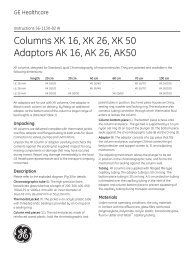
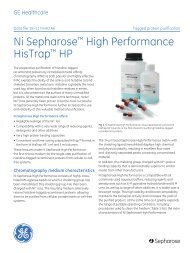
![[PDF] Sample preparation for analysis of protein, peptides and ...](https://img.yumpu.com/21549715/1/190x257/pdf-sample-preparation-for-analysis-of-protein-peptides-and-.jpg?quality=85)
![[PDF] Data File: rProtein A Sepharose Fast Flow](https://img.yumpu.com/21549316/1/190x253/pdf-data-file-rprotein-a-sepharose-fast-flow.jpg?quality=85)
![[PDF] MBP-tagged protein purification](https://img.yumpu.com/21548507/1/184x260/pdf-mbp-tagged-protein-purification.jpg?quality=85)
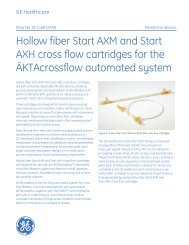
![[PDF] AKTA ready system Data file](https://img.yumpu.com/21540925/1/190x253/pdf-akta-ready-system-data-file.jpg?quality=85)
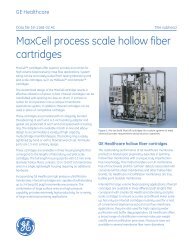
![[PDF] Data File - rProtein A/Protein G GraviTrap](https://img.yumpu.com/21539052/1/190x253/pdf-data-file-rprotein-a-protein-g-gravitrap.jpg?quality=85)
